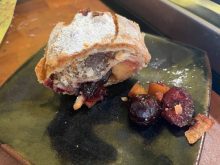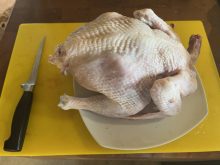When Dave and I started to plan a recent family gathering, we quickly realized a daytime event was more likely to suit our guests than an evening supper. Even as the sun moves back north and daylight hours lengthen, time spent talking after eating often means our guests would face a drive home on gravel country roads in the dark. So supper became brunch.
From a menu planning perspective, brunch’s straddling of two early-ish meals eliminates the traditional large roast or haunch or loin or leg of pork or venison or beef or lamb sometimes served as a centrepiece at dinners and suppers. I can’t recall when I last roasted a big chunk of beef, given that our table routinely seats two for meals, and I love my vegetables and beans. I have gravitated instead toward using meats as flavour agents, small but mighty bites to enhance other stars. In place of a roast, I wondered, did I want to serve breakfast? Maybe poach eggs on greens and ham, maybe make a nice béarnaise sauce? Roast some potatoes and sausages? But the one seemed too fussy and last-minute, and the other seemed too workaday. So, I roasted my smokehouse ham a few days early, cut off a bit toward brunch and shared the rest with my family, made pastry in advance with extra for the freezer, and settled on quiche. A daily quiche had occupied a regular spot on my restaurant’s menu back in the day in Calgary, but Dave couldn’t remember me ever making it at home.
Read Also

Gentle treatments for pain in the neck
Heading toward year-end, people unknowingly tense up against the cold and busyness, causing neck pain that can often be treated with appropriate support and gentle mobility, athletic therapist Kathlyn Hossack says.
The history of quiche is a bit complicated. It originated in the French-German border district known as Lorraine, a hilly and politically important region that changed hands with every European war over the centuries. The local food and culture reflect this dichotomy. Just within the last century or so, the region was claimed by Germany, restored to France at the end of the First World War, occupied again by the German army during the Second World War, and eventually reverted to France.
Quiche is believed to have originated during the Germanic sphere of influence; the word derives from the German word kuchen, or cake. The dish likely began with a 16th-century baker in the district’s capital city of Nancy. He used bread dough as a casing for an egg-and-cream custard seasoned with sauteed smoked bacon, a regional specialty. Sauteed onions eventually were added, as was grated cheese — specifically, flavourful high-mountain cows’-milk cheese, such as Gruyère, Emmenthal or Comté.
Over time, quiche’s reputation diminished as cooks took to using flavourless ingredients in insufficient amounts to withstand the rich custard, and it became a dish scorned by “real men.”
Well, the fact is that smoky ham or bacon, cheese with character, half an onion sauteed with garlic, and farm eggs with good whipping cream and milk create a delicious complexity that belies the dish’s few ingredients — a veritable wall of flavours lightly secured by a tender mortar of custard. First we eat, then we debate the merits of German and French influences in Lorraine.
Quiche au saison

Flavour this to follow the seasons: sauteed asparagus in spring, wilted greens in winter, roasted peppers in fall, gardener’s choice in high summer. In any case, smoked ham or bacon adds the backbone necessary to stand up to the rich custard. This dish can be elaborated by using puff pastry, but pie pastry is perfect. Substituting lower-fat milk or cream adversely affects the texture as well as flavour, so use the full-fat stuff this time.
Serves 4-6.
- 1 recipe pie pastry
- 1 c. diced ham or smoked bacon
- 2 Tbsp. olive oil, lard, butter or bacon fat
- 3 cloves garlic, minced
- ½ onion, finely diced
- ½ c. minced asparagus or other seasonal vegetable
- 1 c. grated Emmenthal or Gruyère cheese
- 1 Tbsp. minced parsley
- 2 whole large eggs + 1 egg yolk
- 1 c. whipping cream
- 1 c. whole milk
- kosher salt and freshly cracked pepper to taste
Line one 8-9” pie plate or fluted tart pan with parchment. Roll out pastry and fit it into pan, fitting it closely into angles without stretching it. Cover and chill for at least 30 minutes.
Preheat oven to 375 F. Dock pastry (prick it in several places with a fork’s tines or the tip of a knife) and place foil or parchment directly on the pastry, including the sides and edges, then add a layer of baking weights. Blind bake for about 30-35 minutes, until golden and baked through on the bottom. Remove foil or paper and baking weights.
Meanwhile, sauté bacon until crisp and set it aside. If using ham, set it aside. Sauté garlic for 30 seconds. Add onion, season generously, cover, reduce heat, and sweat until tender without much browning. Add asparagus and sauté until brightly coloured and tender.
To assemble, layer onion and vegetable mixture with ham or bacon in the pastry, then top with cheese and parsley. Whisk eggs, cream and milk until homogeneous. Season generously. Pour into the filled pastry.
Place quiche on a rimmed baking sheet and bake for 30 minutes, or until just set. Cool slightly before serving.















